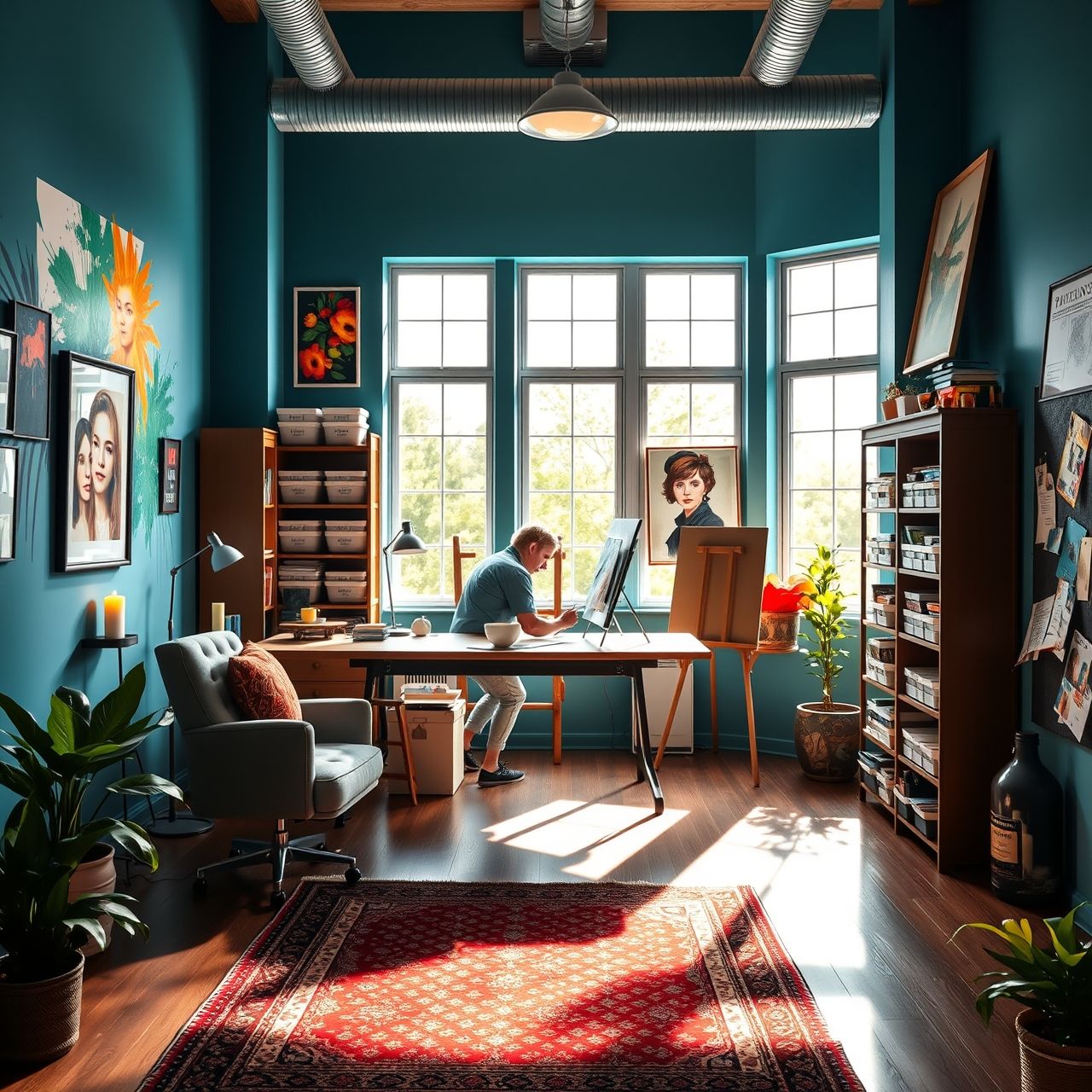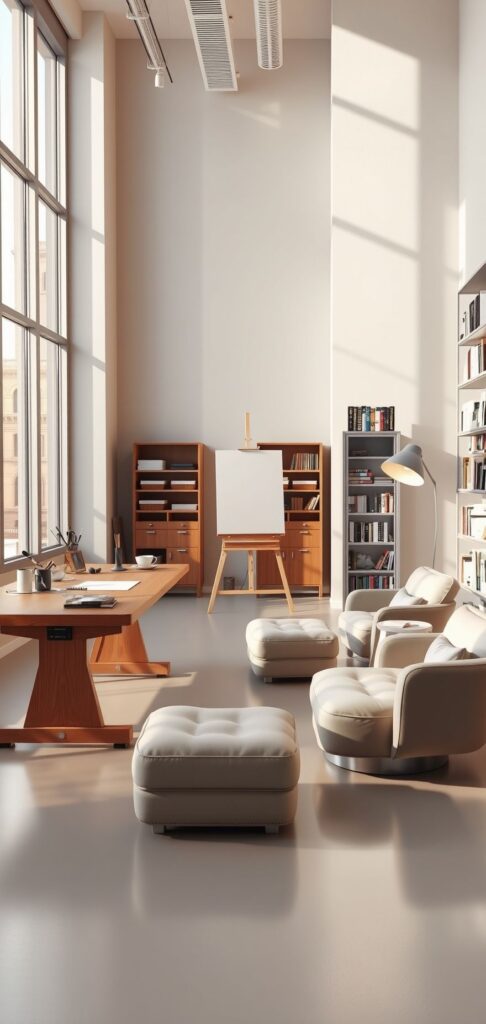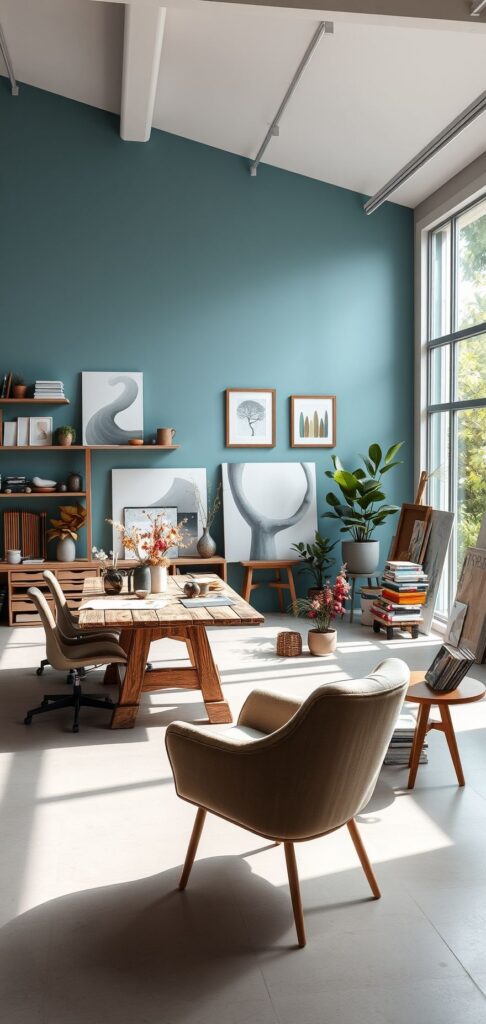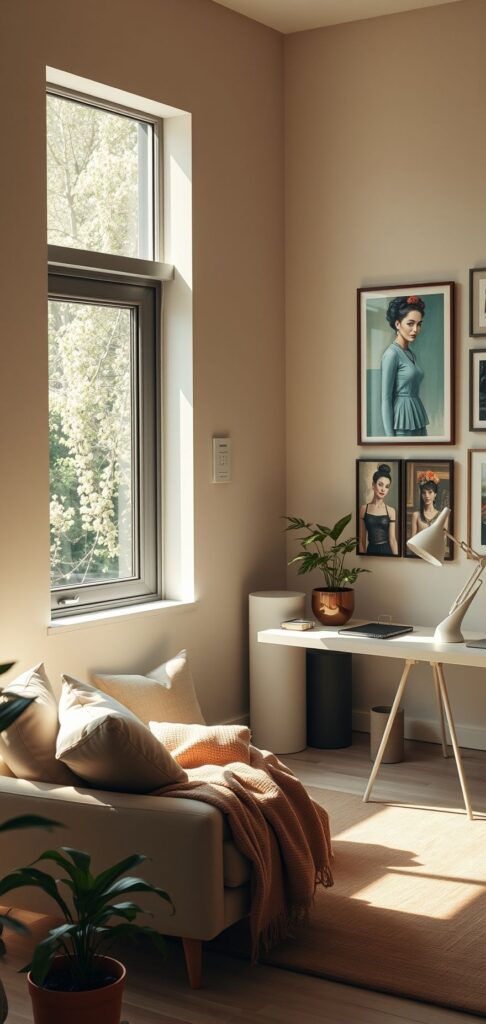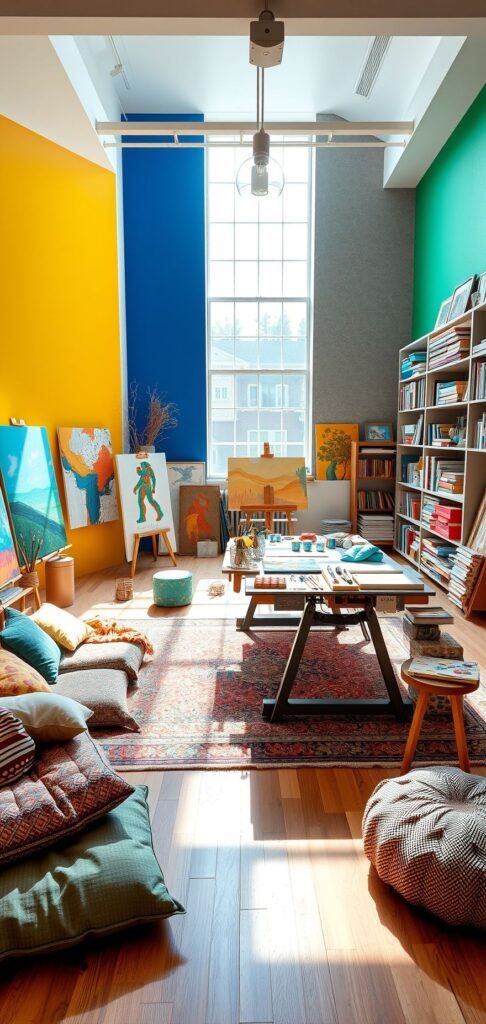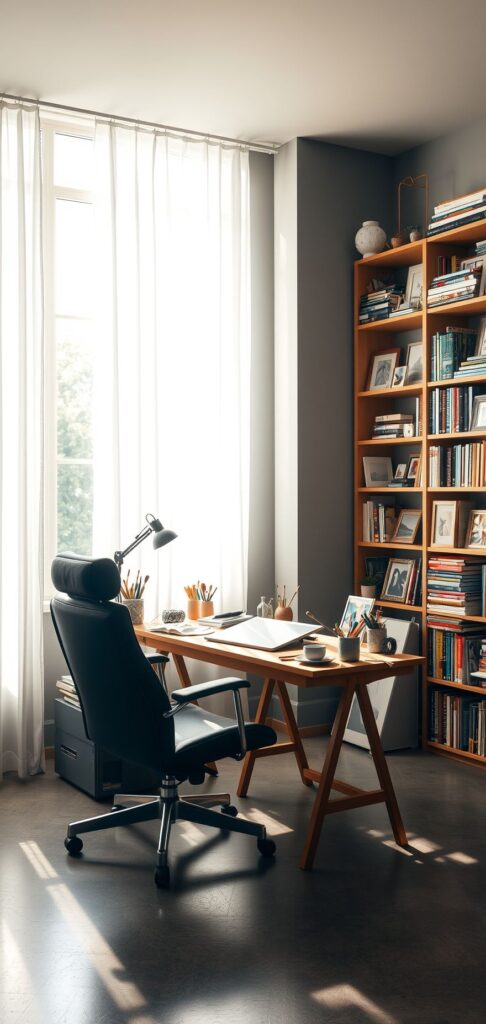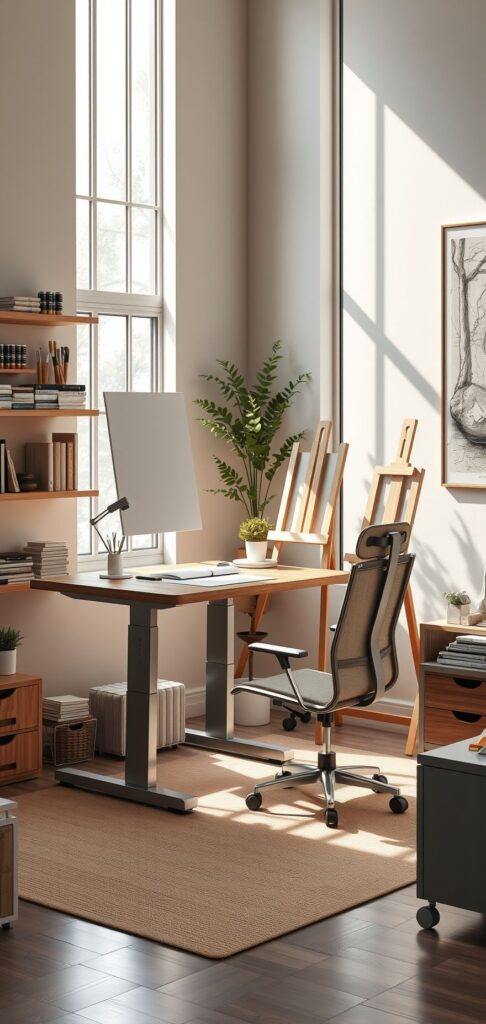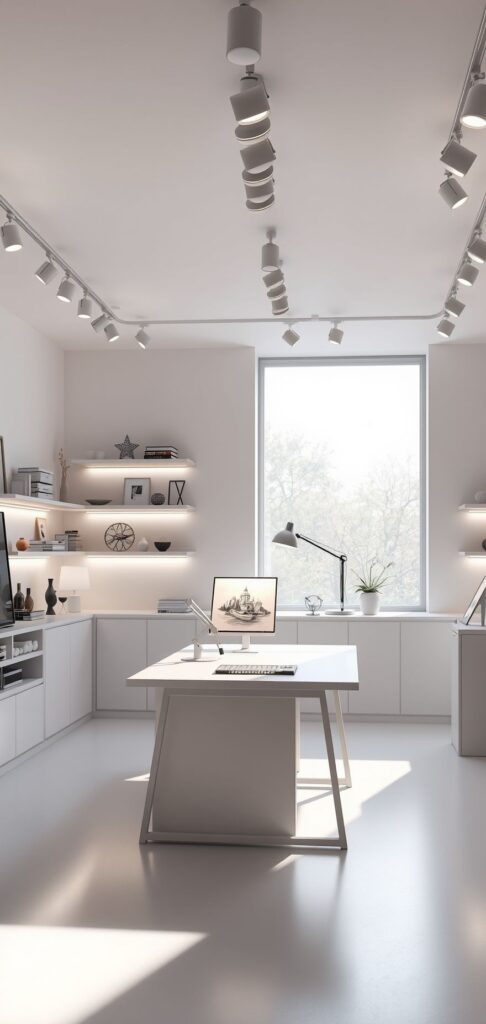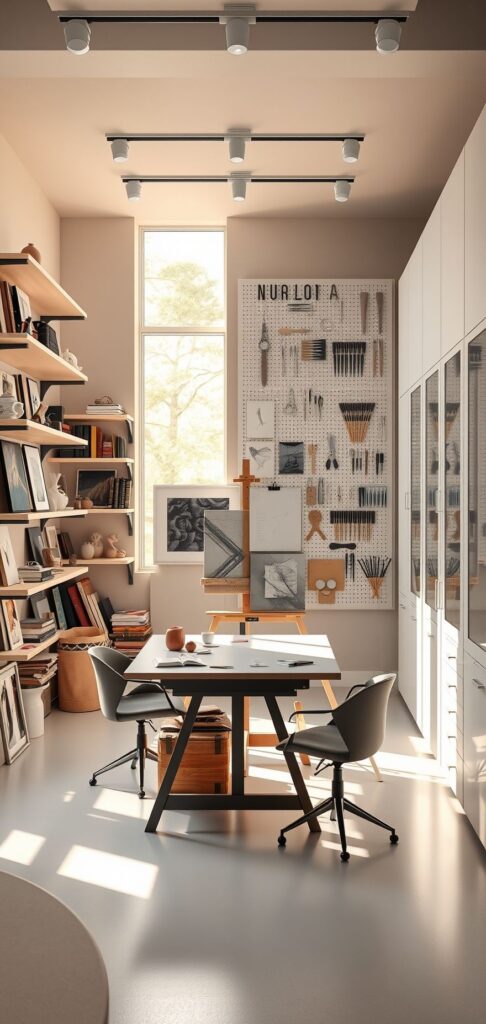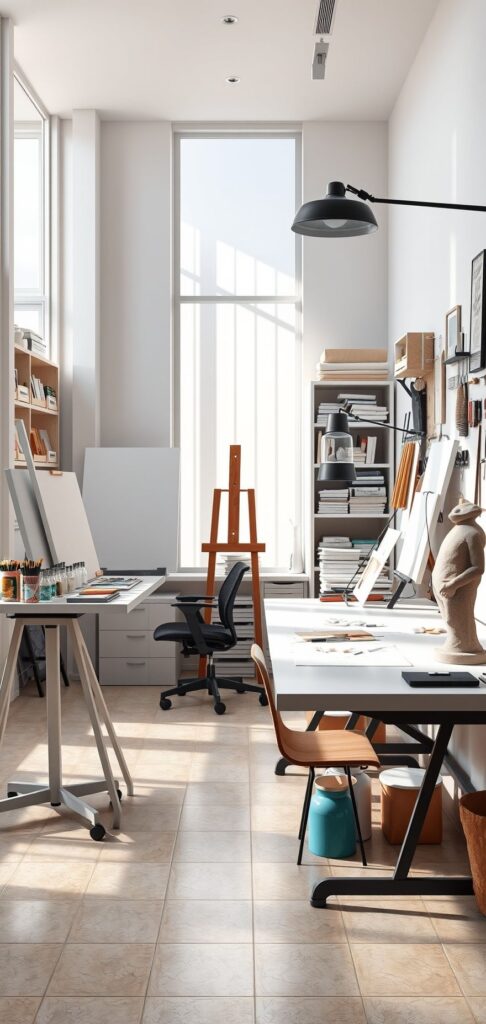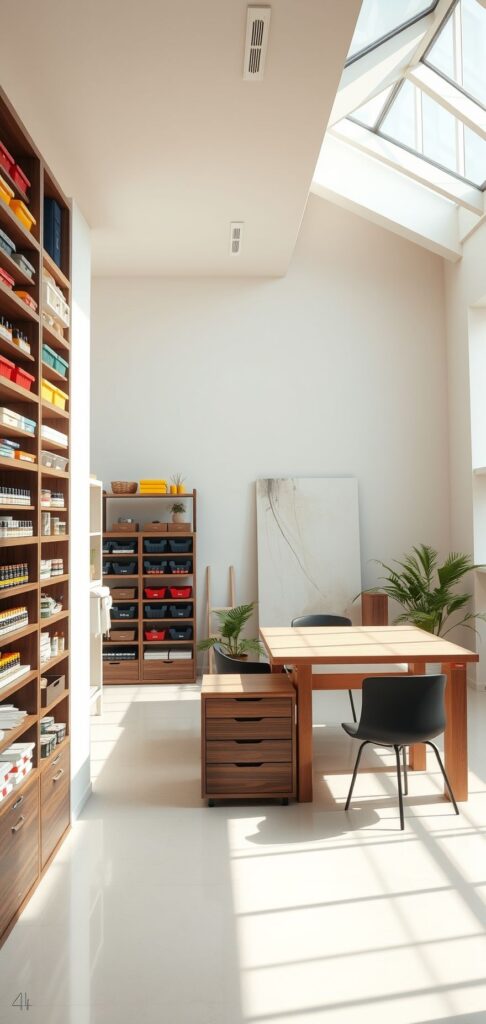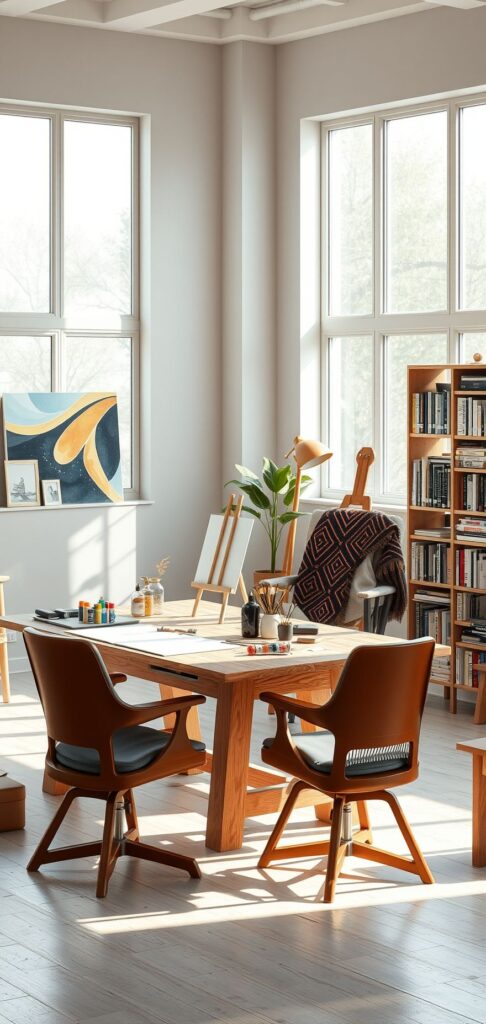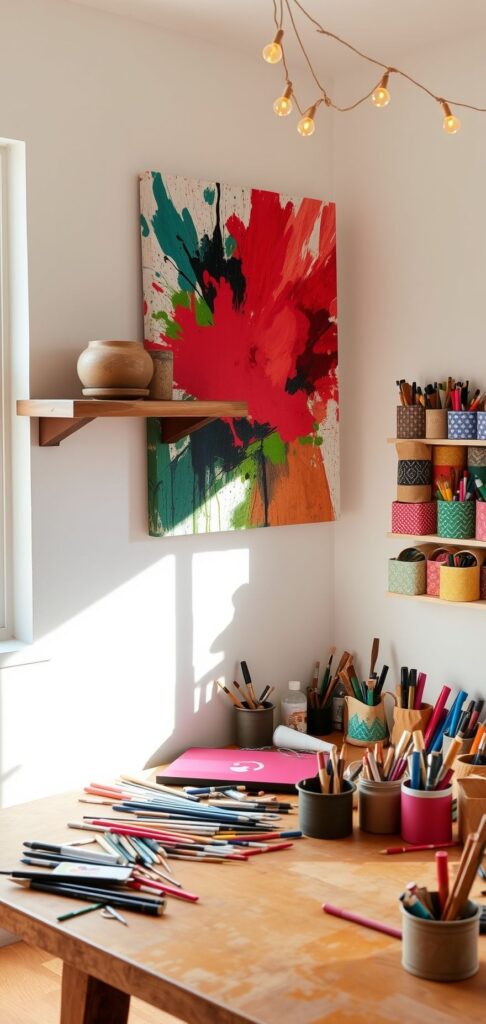Key Takeaways
- Creating a functional and inspiring art studio is more than just choosing the right colors and decor”its about setting up a space that fosters creativity and efficiency.
- Whether you’re a professional artist or a hobbyist, the right room decor can make all the difference.
- Below are key takeaways to help you design a studio that not only looks great but also enhances your artistic process:
- Organize your art supplies with labeled bins and shelves.
- Prioritize natural light with strategically placed windows.
- Incorporate task lighting for precision work.
- Choose functional and ergonomic furniture.
- Use vertical space for storage and display.
- Add personal touches with art-themed decor.
- Create a dedicated area for each task.
- Use color and texture to enhance your creativity.
- Incorporate flexible storage solutions.
- Ensure your studio is a sanctuary for creativity.
By focusing on both the aesthetic and practical aspects of room decor, you can create an art studio that not only looks great but also supports your creative journey. In the following sections, well delve deeper into each of these tips and provide actionable advice to help you design the perfect space for your artistic pursuits.
Imagine walking into a studio that feels like a blank canvas, waiting for your creative touch. Your art space should be more than just a place to work; it should be an inspiring sanctuary that fuels your imagination and enhances your artistic process. Whether you’re a professional artist or a passionate hobbyist, the right room decor can make all the difference.
Creating a functional and inspiring art studio is about more than just choosing the right colors and decor. Its about setting up a space that fosters creativity and efficiency. From organizing your art supplies with labeled bins and shelves to prioritizing natural light and incorporating task lighting, each element plays a crucial role in your workflow. Lets dive into practical tips for designing a studio that not only looks great but also supports your artistic journey.
Room Decor for Artists
The Importance of a Functional Art Studio
A well-designed art studio is more than just a space to create; it’s a sanctuary that fuels creativity and enhances productivity. For artists, the environment in which they work can significantly impact their artistic process. Room decor for artists goes beyond aesthetics; it involves creating a functional and inspiring space that supports the unique needs of creative professionals. A well-organized and visually appealing studio can reduce stress, increase focus, and ultimately lead to more prolific and high-quality work.
Creative Inspiration for Art Rooms
Finding Inspiration for Your Art Studio
Finding inspiration for your art room decor can be a fun and rewarding process. Start by exploring nature, art, and design. Take walks in nature to observe colors, textures, and patterns. Visit galleries and museums to see how other artists use space and light. Follow design blogs and social media accounts to stay updated on the latest trends. Once you have a collection of inspirations, translate them into actionable decor ideas. For example, if you love the serene blues of the ocean, consider painting a wall in a calming blue hue or adding blue accents to your studio.
Art-Themed Decor Items
Adding Personal Touches to Your Studio
Personal touches can transform a space into a true reflection of your artistic identity. Art-themed decor items such as framed prints of your favorite artists, sculptures, and custom wall art can spark creativity and make your studio feel more personal. Plants not only add a touch of nature but also improve air quality and reduce stress. Textiles like throw blankets and cushions can add warmth and comfort to your space. Consider creating a vision board with images, quotes, and materials that inspire you.
Vibrant Colors and Textures in Art Spaces
Using Color and Texture to Enhance Creativity
Vibrant colors and textured surfaces can have a profound impact on the creative process. Bold wall colors like deep blues, vibrant greens, and warm oranges can evoke different emotions and moods. Patterned rugs and textured cushions can add depth and visual interest to your studio. Experiment with different color combinations to find what best stimulates your creativity. For example, a bright yellow wall can energize your space, while a soft gray can create a calming atmosphere.
Natural Light and Its Importance
Maximizing Natural Light in Your Art Studio
Natural light is essential for artists, as it can significantly affect mood and productivity. Position your work area near windows to maximize daylight. If your studio doesn’t have ample natural light, consider using daylight simulation bulbs to mimic the benefits of sunlight. Natural light can also help you see colors more accurately, which is crucial for detailed work. To further enhance the lighting, use sheer curtains or blinds to control the amount of light entering the room.
Home Art Studio Furniture Ideas
Choosing Functional and Ergonomic Furniture
Investing in a sturdy, adjustable desk and a comfortable chair is essential for maintaining good posture and enhancing workflow. A home art studio should be equipped with furniture that supports your physical well-being. Look for desks with ample surface area and adjustable height options to accommodate different tasks. Ergonomic chairs with lumbar support can prevent back pain and promote comfort during long hours of work. Consider multi-functional furniture, such as a desk with built-in storage, to optimize space.
Organizing Your Art Supplies
Creating a Tidy and Efficient Workspace
A clutter-free environment is crucial for maintaining focus and productivity. Labeled bins, shelves, and storage containers can help you keep your supplies organized and easily accessible. Use clear bins for small items like brushes and markers, and larger bins for canvases and paper. Wall-mounted organizers and pegboards are excellent for storing tools and materials vertically, saving floor space. Regularly declutter your workspace to ensure it remains organized and functional.
Task Lighting for Precision Work
Ensuring Every Corner is Well-Lit
Task lighting is essential for detailed artistic work, as it helps reduce eye strain and improve visibility. Consider using adjustable desk lamps with bright, focused light to illuminate your work area. Track lighting can be installed on the ceiling to provide even lighting throughout the studio. LED strip lights under shelves can also add ambient lighting and highlight specific areas. Ensure that every corner of your studio is well-lit to create a comfortable and productive environment.
Vertical Space for Storage and Display
Maximizing Storage with Wall-Mounted Solutions
Utilizing vertical space can significantly enhance storage and display options in your artist’s workspace. Install shelves, hooks, and hanging organizers to keep supplies within reach and save floor space. Floating shelves can be used to display finished pieces or works in progress. Hooks and pegboards are perfect for hanging tools, brushes, and other materials. By maximizing vertical space, you can create a more organized and efficient studio.
Dedicated Areas for Each Task
Designating Specific Zones for Different Activities
Organizing your studio into distinct areas for different activities can streamline your workflow and prevent clutter. Designate a specific area for painting, another for drawing, and a separate space for sculpting. Each zone should be equipped with the necessary tools and materials to ensure smooth transitions between tasks. For example, a dedicated painting area might include a large table, easels, and storage for paints and brushes. A drawing area could have a comfortable chair, a drawing board, and a supply of pencils and paper.
Flexible Storage Solutions
Adapting Your Space as You Grow
As your artistic journey evolves, your storage needs will likely change. Modular storage units and adjustable shelving can help you adapt your space to accommodate new materials and projects. Consider using stackable storage bins and adjustable shelves that can be reconfigured as needed. This flexibility ensures that your studio remains functional and organized, no matter how your creative pursuits evolve.
Making Your Studio a Sanctuary for Creativity
Creating a Comfortable and Inspiring Environment
Designing a space that invites creativity and reduces distraction is crucial for maintaining a productive and enjoyable studio environment. Incorporate elements that make your studio feel like a sanctuary, such as comfortable seating, soft lighting, and personal touches. A cozy reading nook with a comfortable chair and a bookshelf can provide a space for relaxation and inspiration. Scented candles or essential oils can create a calming atmosphere, while background music can enhance focus and creativity.
DIY Art Room Inspiration
Practical Tips for DIY Decor
Personalizing your art room with DIY projects can add a unique touch and make the space feel more personal. Create custom wall art using materials like canvas, wood, and paint. Build a floating shelf from reclaimed wood to display your favorite pieces. Make your own storage bins from fabric and cardboard to organize small items. DIY projects not only save money but also allow you to tailor your decor to your specific tastes and needs. Follow step-by-step guides to ensure your projects are both functional and beautiful.
A well-designed art studio is more than just a physical space; it is a sanctuary that fuels creativity and enhances productivity. By understanding the importance of a functional and inspiring environment, artists can create a studio that supports their unique needs and enhances their artistic process. From finding inspiration in nature and design to incorporating vibrant colors, textures, and natural light, every element plays a crucial role in fostering a creative atmosphere.
Investing in functional and ergonomic furniture, organizing art supplies efficiently, and ensuring well-lit work areas are essential for maintaining a clutter-free and productive workspace. Utilizing vertical space and designating specific zones for different activities further optimize the studio’s functionality. As artists grow and evolve, adaptable storage solutions ensure that the space remains organized and functional.
Ultimately, creating a studio that feels like a sanctuary complete with personal touches, comfortable seating, and a calming atmosphere can make all the difference in the creative journey. Whether through DIY projects or thoughtful decor, personalizing your art room can transform it into a space where creativity flourishes.

